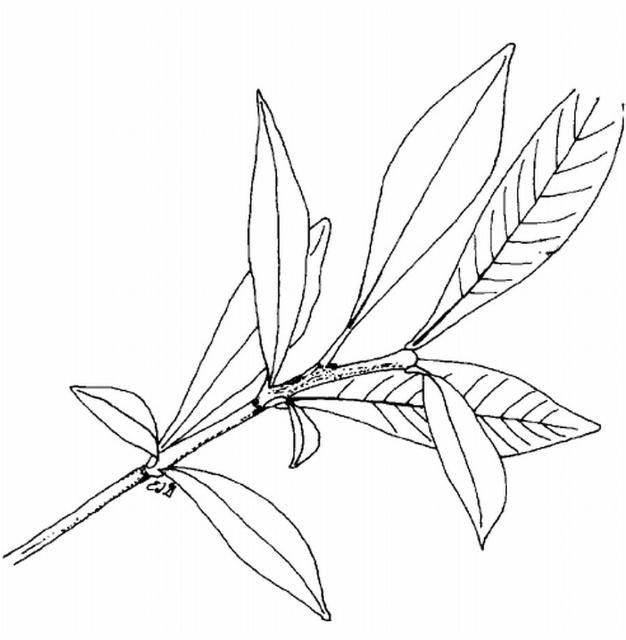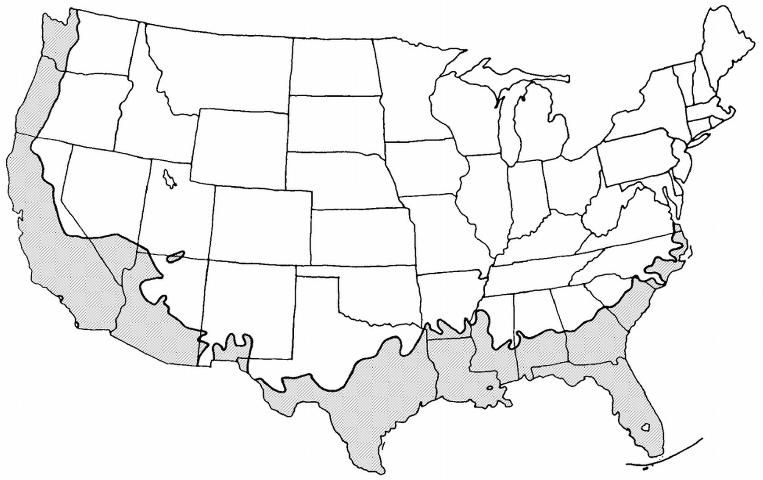Introduction
This dwarf cultivar of Gardenia jasminoides is much different from the species (Figure 1). Trailing gardenia reaches a height of 2 to 3 feet and can spread 4 to 6 feet. This plant has an open, horizontal branching habit that makes it an attractive ground cover. It will not grow into a shrub as does the species. The small, dark, lustrous, green leaves generally occur on the stems in 3s. The leaf veins of this cultivar are not as prominent as the species. The leaves are accompanied by one-inch, white, fragrant flowers in the spring and summer. The fruits of trailing gardenia are small, ovate berries that are relatively inconspicuous.

General Information
Scientific name: Gardenia jasminoides 'Prostrata'
Pronunciation: gar-DEEN-ee-uh jass-min-OY-deez
Common name(s): dwarf gardenia
Family: Rubiaceae
Plant type: ground cover
USDA hardiness zones: 8 through 10 (Figure 2)
Planting month for zone 8: year round
Planting month for zone 9: year round
Planting month for zone 10 and 11: year round
Origin: not native to North America
Uses: ground cover; container or above-ground planter; mass planting; cascading down a wall
Availablity: generally available in many areas within its hardiness range

Description
Height: 2 to 3 feet
Spread: 3 to 6 feet
Plant habit: spreading; prostrate (flat)
Plant density: dense
Growth rate: moderate
Texture: fine
Foliage
Leaf arrangement: whorled
Leaf type: simple
Leaf margin: entire
Leaf shape: ovate
Leaf venation: pinnate
Leaf type and persistence: evergreen
Leaf blade length: less than 2 inches
Leaf color: variegated
Fall color: no fall color change
Fall characteristic: not showy
Flower
Flower color: white
Flower characteristic: pleasant fragrance; spring flowering; summer flowering
Fruit
Fruit shape: oval
Fruit length: 1 to 3 inches
Fruit cover: fleshy
Fruit color: orange
Fruit characteristic: inconspicuous and not showy
Trunk and Branches
Trunk/bark/branches: usually with one stem/trunk
Current year stem/twig color: green
Current year stem/twig thickness: thin
Culture
Light requirement: plant grows in part shade/part sun
Soil tolerances: clay; sand; acidic; loam
Drought tolerance: moderate
Soil salt tolerances: poor
Plant spacing: 24 to 36 inches
Other
Roots: not applicable
Winter interest: no special winter interest
Outstanding plant: not particularly outstanding
Invasive potential: not known to be invasive
Pest resistance: very sensitive to one or more pests or diseases which can affect plant health or aesthetics
Use and Management
This plant is great in planter boxes or pots and makes a lovely border plant. It is also a good mass or facing plant for the front of a shrub border. Trailing gardenia will also cascade nicely over a wall. It is most commonly used as a ground cover.
Position this plant in an area that receives full sun or partial shade. Trailing gardenia prefers acidic, well-drained soils that are of medium fertility. It is moderately drought tolerant and can be grown throughout Florida. However, this cultivar is not as cold hardy as the species. Plants that are regularly fertilized maintain a dark green color.
Gardenia jasminoides 'Prostrata' is commonly propagated by softwood cuttings in June, July, and August. Seeds can also be used to grow this plant.
The cultivar 'Radicans Variegata' has white variegations on most leaves. Some nurseries and catalogues refer to 'Prostrata' as 'Radicans'. They can be used interchangeably in landscape applications.
Pest and Diseases
Trailing gardenia is susceptible to white fly, scale, and aphids and, therefore, requires some attention to keep it looking nice and healthy. Plants in poorly drained soil often develop yellow leaves and grow poorly.